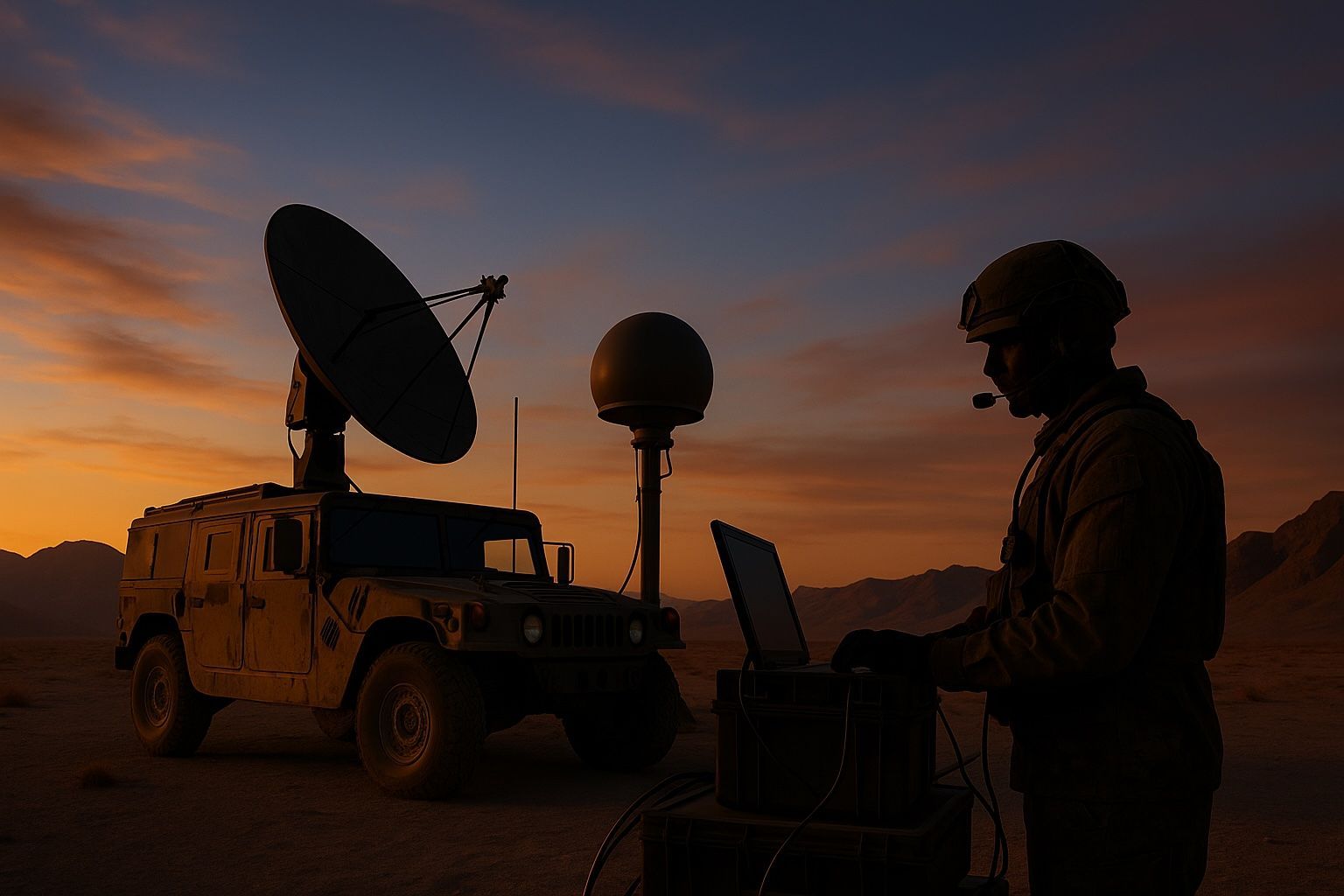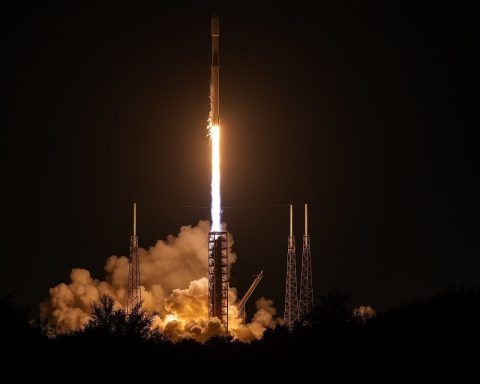- The United States operates the Advanced Extremely High Frequency (AEHF) constellation, delivering jam-resistant, global, protected military communications including nuclear command and control links.
- Navstar GPS is a 31-satellite global navigation system that provides precise positioning, navigation, and timing to guide munitions such as JDAM and to synchronize encrypted networks.
- Defense Support Program (DSP) and the Space-Based Infrared System (SBIRS) form the U.S. early-warning constellation that uses infrared sensors to detect missile launches worldwide.
- U.S. Keyhole KH-11 optical reconnaissance satellites (and successors) provide high-resolution imagery from space.
- Russia operates the Liana ELINT constellation, including Lotos-S1 in low orbit and Pion-NKS in higher orbits, to intercept radar and communications.
- China completed the BeiDou navigation constellation in 2020, delivering global PNT with a military short-messaging capability.
- The U.S. Space Development Agency aims to deploy about 160 satellites in the Proliferated Warfighter Space Architecture by the end of 2025.
- Commercial SpaceX Starlink, with its Starshield military derivative, is being used to provide resilient communications and hosted payloads for armed forces.
- China’s 2007 anti-satellite test and Russia’s 2021 direct-ascent ASAT test created large debris clouds, increasing space threat and debris risk.
- Artificial intelligence and onboard processing are enabling autonomous satellite operations and sensor fusion, guiding the development of smart constellations planned for the 2030s.
Introduction: Modern military forces rely heavily on satellites as force multipliers and intelligence assets in space. Over the last few decades, warfare has shifted toward highly technology-driven operations, making space-based capabilities central to strategic planning [1]. Military satellites – once limited to Cold War-era spy missions – now form the ever-watchful “eyes in the sky,” delivering critical communications, surveillance, navigation, and early warning services to militaries worldwide [2]. These orbital platforms enable real-time intelligence and global connectivity that dramatically enhance a nation’s military reach and responsiveness. In this report, we explore the types of military satellite services, their roles in modern warfare, the technologies that empower them, and the global landscape of military space capabilities. We also discuss recent innovations, emerging threats, and future trends shaping the next generation of military satellites.
Types of Military Satellite Services
Military satellites serve diverse functions in support of defense and security. Key categories include communications, reconnaissance/surveillance, navigation, early warning, signals/electronic intelligence, and weather support satellites [3]. Each type is purpose-built with specialized payloads and instruments to fulfill its mission. Below is an overview of these satellite types and their roles:
Communications Satellites (SATCOM)
Communication satellites enable secure, long-distance connectivity for military forces across the globe. They act as relay stations in orbit, carrying voice, data, and video between far-flung command centers, troops, ships, and aircraft [4]. Military SATCOM systems typically operate in high orbits (e.g. geostationary) to cover large areas and use encrypted, jam-resistant channels for reliability [5] [6]. They support a range of critical functions, from routine unit coordination to high-level command and control. For example, the U.S. Advanced Extremely High Frequency (AEHF) constellation provides survivable, global, protected communications – including nuclear command & control links – even under adversary jamming or nuclear conditions [7] [8]. By delivering robust beyond-line-of-sight communication, SATCOM satellites connect the C4ISR network (Command, Control, Communications, Computers, Intelligence, Surveillance, Reconnaissance), ensuring commanders can communicate orders and receive intelligence in real time.
Reconnaissance & Surveillance Satellites (Spy Satellites)
Reconnaissance or spy satellites gather vital intelligence by imaging or scanning the Earth’s surface. Equipped with advanced sensors – high-resolution optical telescopes, infrared cameras, and synthetic aperture radar (SAR) – these satellites can photograph enemy installations, track troop movements, and monitor technological developmentsfrom space [9]. They operate from low Earth orbit (LEO) or highly elliptical orbits to attain detailed views of targets. Key functions include capturing high-resolution imagery of bases or battlefields, detecting heat signatures of concealed or nighttime activity, and even spotting missile launch sites or underground facilities [10]. For instance, U.S. Keyhole/CRYSTAL series satellites (KH-11 and successors) and China’s Yaogan satellites carry powerful optics and radar to enable detailed surveillance from orbit [11]. By providing commanders with near-real-time imagery and mapping, reconnaissance satellites deliver situational awareness that is impossible to achieve from the ground. These systems allow long-term monitoring of global “hot spots” and help guide military planning without alerting the adversary [12].
Navigation Satellites (Positioning, Navigation, Timing)
Navigation satellite constellations provide precise positioning, navigation, and timing (PNT) services essential for modern military operations. Systems like GPS (Navstar), operated by the U.S. Space Force, broadcast timing signals that receivers use to triangulate their location on Earth [13]. This enables forces to know their exact position and synchronize operations worldwide. Military navigation satellites underpin smart weapons guidance, allowing munitions (e.g. JDAM bombs, cruise missiles) to strike targets with pinpoint accuracy using GPS coordinates [14]. They also assist troop movement, map navigation, and timing synchronization for encrypted networks [15]. In addition to GPS, other countries operate similar systems – Russia’s GLONASS, China’s BeiDou, Europe’s Galileo, and India’s NavIC – often with encrypted military-specific signals for greater accuracy and anti-jamming resilience [16] [17]. By delivering global PNT data, navigation satellite services have become indispensable for precision-guided weapons, coordination of maneuvers, and any mission that depends on accurate timing.
Early Warning Satellites (Missile Detection)
Early warning satellites serve as a first-alert against missile attacks and nuclear threats. Stationed in geostationary or high-altitude orbits, these satellites use infrared (IR) sensors to detect the telltale heat plumes of ballistic missile launches rising through the atmosphere [18]. Within seconds of a launch, they can spot an Intercontinental Ballistic Missile (ICBM) or other rockets and track its trajectory, providing notice of a potential strike [19]. Systems like the U.S. Defense Support Program (DSP) satellites and newer Space-Based Infrared System (SBIRS) constellation continuously scan for missile launch heat signatures worldwide [20]. Their data is fed to command centers and air defense networks to alert interceptor missiles and civil authorities in case of an incoming attack [21]. Early warning satellites thus support strategic defense and deterrence by reducing the chance of a surprise missile strike [22]. Russia and China similarly deploy early-warning satellites (e.g. Russia’s Tundra satellites) to monitor for launches, often complementing ground-based radars [23]. These satellites are critical for maintaining a credible missile defense posture, as they extend the detection horizon to virtually the entire globe.
Signals Intelligence Satellites (SIGINT/ELINT)
Signals intelligence (SIGINT) satellites intercept and analyze electronic emissions (radio, radar, communications) from adversaries. Sometimes categorized into COMINT (communications intelligence) or ELINT (electronic intelligence), these satellites carry sensitive antennas and receivers to eavesdrop on enemy radio communications, military radar signals, microwave links, or other electronic transmissions from space. By tuning into these signals, SIGINT satellites can locate radar installations, characterize weapon systems, and gather communications chatter without deploying assets inside hostile territory. For example, Russia’s Liana satellite network (comprising Lotos and Pion satellites) is designed to collect signal intelligence over land and sea, helping track naval vessels and other assets via their electromagnetic emissions [24]. India’s EMISAT serves a similar role, detecting and geolocating radar emitters to aid in electronic intelligence and targeting [25]. The United States has long operated classified SIGINT satellites (e.g., the Orion/Mentor series in geostationary orbit) that intercept foreign communications and radar signals for the NSA and military. These platforms require advanced antennae arrays, onboard signal processors, and encryption to securely downlink the gathered intel. SIGINT satellites provide invaluable insight into an adversary’s capabilities and intentions by literally “listening” to the enemy’s electronic footprint from above.
Weather and Earth Observation Satellites
Weather satellites might not sound as glamorous as spy sats, but they play a crucial military support role. Armed forces depend on accurate meteorological data for mission planning, and dedicated military weather satellites (or dual-use civil satellites) supply real-time environmental intelligence. They track cloud cover, storms, fog, ocean conditions, and other weather phenomena that could affect operations [26]. For example, the U.S. Defense Meteorological Satellite Program (DMSP) satellites monitor global weather to inform flight operations, troop movements, and targeting decisions [27]. Knowing the timing of a storm or the extent of cloud cover can determine when to schedule airstrikes or whether drones can surveil an area. Weather satellites also aid in strategic mobility (choosing routes free of severe weather for aircraft or ships) and even support humanitarian missions by assessing disaster impacts [28]. Other nations similarly leverage weather data from space: China’s Fengyun satellites, Europe’s Meteosat programs, and India’s INSATseries all provide meteorological imagery used by their defense establishments. By reducing weather uncertainty, these satellites help militaries schedule operations for optimal conditions and avoid potentially costly surprises from Mother Nature.
Strategic and Tactical Roles in Modern Warfare
Military satellites have become linchpins of modern warfare, providing capabilities that are critical at both the strategicand tactical levels of conflict. On the strategic side, satellites enhance national power by enabling global surveillance, secure worldwide communications, and nuclear early warning – functions that bolster deterrence and informed decision-making. At the tactical level, satellites dramatically improve battlefield awareness, precision, and command/control for deployed forces. Their presence effectively shrinks the distance between sensors, shooters, and commanders, allowing militaries to act faster and with greater accuracy than ever before.
Strategic Roles: From a high-level perspective, satellites contribute to national security strategy and deterrence. Global reconnaissance satellites grant insight into adversaries’ military activities (such as detecting deployments or weapons tests) that leaders rely on for strategic assessments. Early warning satellites, as discussed, provide missile launch detection – a cornerstone of nuclear deterrence strategy, ensuring no surprise attack goes unnoticed [29]. Communications satellites support nuclear command and control networks and links to deployed forces worldwide, guaranteeing that even in a crisis, leaders can communicate orders (e.g. the survivable AEHF system for U.S. nuclear forces) [30]. In essence, satellites form an “informational high ground,” giving nations strategic oversight and secure connectivity spanning the globe. This enables power projection (e.g. coordinating far-flung military assets via satellite) and strengthens alliances through shared satellite intelligence and GPS services. Militaries with advanced satellite constellations can coordinate multi-theater operations and respond to threats on a global scale – a decisive strategic advantage [31]. In the words of a U.S. Army War College study, satellites and counterspace systems have proven to be “important parts of modern warfare”, with their proliferation and commercialization affecting how wars are conducted [32]. Simply put, control of space translates to enhanced strategic posture on Earth.
Tactical Roles: On the battlefield, satellites act as a force multiplier by enabling precision and real-time awareness. Imaging and surveillance satellites feed live data to commanders, allowing immediate, informed decisions based on current ground truth [33]. Live satellite imagery and infrared scans can reveal enemy positions or hidden units, turning what might have been ambushes into opportunities to outmaneuver the opponent [34]. This unprecedented situational awareness allows forces to shift from reactive to proactive operations, adapting quickly and minimizing surprises [35]. Satellites also empower precision targeting: GPS satellites enable precision-guided munitions to strike within meters of intended targets [36], and satellite links feed target coordinates to unmanned aerial vehicles (UAVs) or other weapon systems [37]. The result is that smaller units can deliver outsized effects – fewer troops or platforms are needed to achieve a mission, since satellite guidance and intel make each strike far more effective [38]. Secure satellite communications, meanwhile, ensure that frontline patrols, ships at sea, and aircraft can all stay connected with command centers, even in remote areas or during high-tempo operations [39]. This is vital for coordinating joint operations and for command and control in fast-moving conflicts. In summary, satellites allow military forces to see deeper, communicate farther, and strike more precisely, thereby enhancing both offensive and defensive operations on tactical timescales [40] [41]. Real-world conflicts underscore this value – for example, high-resolution commercial satellite imagery and satellite internet have been key in the Ukraine war, giving Ukrainian forces intelligence on Russian movements and robust communications that offset terrestrial network disruptions [42] [43]. Such examples illustrate that dominance in the space domain can decisively influence outcomes on the ground.
Key Technologies in Military Satellites
Military satellites are cutting-edge systems that incorporate a range of advanced technologies to achieve their mission objectives. Some of the key technologies and components that enable military satellite services include:
- Advanced Sensors and Payloads: The “eyes” and “ears” of military satellites are their sophisticated sensor payloads. Optical telescopes with large-aperture mirrors capture high-resolution electro-optical images, while infrared sensors detect heat signatures (useful for night or camouflaged target detection) [44]. Synthetic Aperture Radar (SAR) instruments actively illuminate the ground with radar and can see through clouds or at night, producing all-weather imagery. For signals intelligence, satellites carry specialized antenna arrays and receivers tuned to pick up radio communications or radar emissions. These payloads often leverage high-sensitivity electronics and onboard data processing to filter and compress the collected data. For instance, modern imaging satellites can digitize imagery at sub-meter resolution and encrypt it for downlink to analysts on the ground. The quality and diversity of sensors – from multi-spectral cameras to electronic signal collectors – determine how much and what type of intelligence a satellite can gather.
- Secure Communications and Encryption: Because military satellites relay some of the most sensitive information (e.g. battlefield comms, reconnaissance data), they employ robust encryption and anti-jammingtechnologies. Satellite communication links use advanced encryption protocols to prevent interception of data by adversaries. Frequency-hopping spread spectrum and other anti-jam techniques are used so that enemy electronic warfare units cannot easily disrupt the signal. The U.S. AEHF satellites, for example, provide jam-resistant, highly secure communications even in contested environments [45]. Military SATCOM payloads also use directional high-gain antennas and operate in frequencies less susceptible to interference (such as the Extremely High Frequency band) to enhance link reliability [46]. These technologies ensure that messages and data transmitted via satellite remain confidential and usable, even under deliberate jamming or cyberattack attempts. In addition, satellites often have cross-link communications (laser or radio links between satellites) so that data can be routed in space directly to an appropriate ground station, reducing exposure to interception.
- Propulsion and Maneuvering Systems: To position satellites in optimal orbits and to dodge threats, propulsion is critical. Military satellites typically carry chemical thrusters for orbital insertion and station-keeping maneuvers, and many now also use electric propulsion (ion thrusters) for efficient, prolonged adjustments. Chemical propulsion provides high thrust (useful for quickly changing orbit or evading an anti-satellite interceptor), but fuel supply is limited; electric propulsion offers far greater fuel efficiency for small adjustments, albeit with low thrust over longer durations [47]. This combination allows satellites to maintain their orbital slots and, to a limited extent, maneuver if threatened. However, current satellites with conventional propellants still have constrained agility – they are often in predictable orbits, making them potential “sitting ducks” for enemy ASAT weapons [48] [49]. To address this, future military satellites are exploring advanced propulsion like nuclear-thermal or solar-electric engines that would enable more rapid and extensive maneuvering [50] [51]. Improved propulsion and fuel capacity can extend a satellite’s service life and give operators more options to reposition assets or dodge space debris and attacks. In essence, maneuverability is becoming an increasingly valued technology for satellite survivability in contested space.
- Onboard Processing and Autonomy: Modern military satellites often include powerful onboard computers and are beginning to utilize artificial intelligence (AI) and machine learning for autonomy. Onboard processing allows initial analysis of sensor data in space (for example, flagging likely targets in an image before sending it down), which saves bandwidth and time. AI algorithms can enable satellites to identify anomalies or targets on their own, or to manage their systems intelligently (for power, thermal, etc.). The U.S. Space Force has highlighted AI’s role in space domain awareness – using AI to analyze the orbits of thousands of objects and detect unusual behavior or threats to satellites [52] [53]. In the future, satellites may operate more autonomously in a conflict – e.g. maneuvering to avoid a collision or jamming attempt without waiting for human commands [54]. Onboard secure processors and radiation-hardened electronics are crucial so that satellites can survive the harsh space environment (solar radiation, etc.) and possibly the electromagnetic pulses of nuclear events. By equipping satellites with advanced computing and AI, militaries aim to reduce latency (faster response) and increase resilience (satellites “thinking” for themselves if cut off from ground control).
- Stealth, Survivability and Hardening: Though less often discussed publicly, some military satellites incorporate stealth or countermeasures to enhance survival. This can include low-observability coatings or shapes to make them harder to track by radar or optical telescopes from the ground. Satellites are also engineered for resiliency: redundant systems, armored components, and radiation shielding help them withstand both natural and man-made hazards. For instance, electronics may be shielded against radiation and hardened to survive the flash of a nuclear detonation (important for maintaining capability in a nuclear conflict). Thermal control systems manage heat from the sun or weapon lasers. Additionally, satellite designers consider cybersecurity at every level – encryption (as noted), authentication of commands, and anti-tamper measures – to prevent hijacking or malicious intrusion into satellite controls [55] [56]. All these technologies combined (sensors, secure comms, propulsion, processing, and hardening) make modern military satellites extremely capable and robust platforms, albeit complex and costly to develop.
Global Military Satellite Operators and Capabilities
Satellites have become a barometer of military and technological strength, with the leading spacefaring nations deploying extensive military constellations. The United States, Russia, and China are the top three operators of military satellites by a wide margin, while several other countries maintain smaller yet significant fleets [57]. This section provides an overview of the major military space powers, the organizations responsible, and the current satellite constellations and systems they operate.
United States: The United States possesses the most advanced and numerous military satellites, operating approximately 123 dedicated military satellites (as of mid-2020s) – by far the largest fleet in the world [58]. These assets are managed jointly by organizations like the U.S. Space Force (under the Department of Defense) and the National Reconnaissance Office (NRO) for intelligence spacecraft [59]. U.S. military satellites span every category: high-resolution imaging (KH-11/Kennon electro-optical spy satellites and radar imaging satellites), signals intelligence collectors, the GPS navigation constellation, Defense Support Program and SBIRS early warning satellites, and multiple communications networks. Notable systems include the Advanced Extremely High Frequency (AEHF) and Wideband Global SATCOM (WGS) satellites for communications, which provide hardened, global links for tactical forces and strategic leadership [60]. In intelligence, the Keyhole series (optical reconnaissance) and Lacrosse/Onyxseries (radar imaging) offer detailed surveillance capabilities, while NRO SIGINT satellites (often in geostationary or Molniya orbits) eavesdrop on strategic communications [61] [62]. The U.S. invests heavily in keeping its space assets at the cutting edge, regularly launching new generations to replace aging birds. Space Force initiatives also focus on protecting satellites from interference (through encryption, maneuverability, and potential active defenses) [63]. Overall, the U.S. leverages its space dominance to support precision warfare, global power projection, and integrated operations with allies – truly viewing space as a critical warfighting domain.
Russia: Russia (and previously the Soviet Union) has a long history in military space and currently operates around 70–74 military satellites, the second-largest number globally [64] [65]. Although significantly fewer than the U.S., Russia’s constellation covers key areas of reconnaissance, communication, navigation, and early warning. For imagery intelligence, Russia has deployed Persona and Bars-M optical spy satellites in low orbit for high-resolution imaging of tactical targets [66]. In early warning, Russia has been fielding its “Tundra” (EKS) satellites to replace the older Oko system, aiming to detect ballistic missile launches threatening Russia [67]. For navigation, Russia maintains the GLONASS satellite network, which provides global positioning services analogous to GPS for Russian military and civilian use [68]. Communications needs are served by satellites such as Meridian and Blagovest (for military coms in various orbits), ensuring connectivity for Russian forces across its vast territories. Russia also retains specialized systems like the Liana signals intelligence constellation, which includes Lotos satellites in low orbit and Pion-NKS in higher orbits to intercept radio emissions and track naval vessels [69]. Despite budgetary and technology challenges post-Soviet era, Russia prioritizes space-based intelligence and ballistic missile early warning as core to its national defense [70]. It has also invested in counterspace capabilities – developing anti-satellite weapons and jammers – likely informed by its recognition that it cannot match U.S. satellite quantity but could threaten them (Russia demonstrated a direct-ascent ASAT in 2021 that created a large debris cloud) [71]. To protect its own assets, Russia emphasizes redundancy and mobile ground stations, preparing to operate even under hostile conditions [72]. In summary, Russia remains a formidable, if second-tier, military space power focused on strategic deterrence and regional surveillance.
China: China has rapidly expanded its military space program, now operating an estimated 60–70 military satellitesdedicated to defense and intelligence missions [73]. Over the past two decades, China moved from having only a handful of military satellites to deploying constellations that rival some of Russia’s capabilities and in some areas approach those of the U.S. This growth is driven by a state-directed effort treating space as a key warfighting domain, combined with civil-military fusion in its space industry [74]. China’s Yaogan series of satellites is a backbone of its ISR (Intelligence, Surveillance, Reconnaissance) efforts – this designation actually covers dozens of satellites carrying various sensor payloads (high-resolution electro-optical cameras, SAR radars, and electronic intelligence packages) to provide broad coverage of Earth [75] [76]. In communications, China has deployed data relay satellites like Tianlian(to support communications with its space assets and military) and likely military communication satellites analogous to the U.S. WGS. Uniquely, China’s BeiDou navigation constellation (completed in 2020) not only provides global PNT service similar to GPS, but also includes short messaging capability for use by Chinese military units in remote areas [77]. For maritime surveillance, China operates satellites such as Yaogan-H variants and the Haiyang series to monitor naval movements – an important aspect given China’s focus on the South China Sea and Pacific region [78]. Beijing is also believed to be developing or deploying early warning satellites as part of its missile defense or offense detection apparatus, reportedly with some cooperation from Russia in recent years to jump-start this capability. Moreover, China has aggressively pursued counterspace technologies: it conducted a notorious ASAT missile test in 2007 (destroying a satellite and creating thousands of debris pieces), and continues to test ground-based lasers, jammers, and co-orbital “inspector” satellites that could disrupt or disable adversary spacecraft [79] [80]. Such efforts indicate China’s intent not only to use satellites for its own military effectiveness but also to deny space-based advantages to its adversaries if conflict arises. With nearly 70 military satellites and growing, China’s military space capability has become a core component of its power projection and anti-access/area-denial strategy in the Asia-Pacific [81].
Other Countries and Alliances: Several other nations maintain smaller military satellite fleets, often focusing on specific niche capabilities or regional needs. France leads European military space efforts with about 17 military satellites [82], including Helios 2 and CSO optical imaging satellites (for reconnaissance), CERES satellites (a trio launched in 2021 for signals intelligence), and Syracuse communications satellites for secure links to French forces and NATO allies. Israel has around a dozen military satellites [83], leveraging its expertise in small, high-performance systems like the Ofek series of reconnaissance satellites and communication relays that provide regional coverage over the Middle East. India has been bolstering its military space assets as well – with roughly 9 military satellites operational [84] – including Cartosat-2 earth observation sats and RISAT radar sats for surveillance, GSAT-7 and GSAT-7A for naval and air force communications, and the IRNSS/NavIC regional navigation system for positioning services [85]. Notably, India demonstrated an anti-satellite weapon in 2019 (Mission Shakti), underlining its entry into the counterspace arena [86]. Japan operates a few key satellites for reconnaissance (e.g. IGS optical and radar satellites) and a regional QZSS navigation augmentation system, while Germany and Italy each have deployed high-resolution radar satellites (Germany’s SAR-Lupe and SARah, Italy’s COSMO-SkyMed) and share in some communications satellite programs (e.g. Italy’s SICRAL, Spain’s Spainsat, etc.). The United Kingdom operates the Skynet military communication satellites, a long-running program currently on Skynet-5/6, to support British and allied forces. NATO as an alliance has begun initiating its own small capabilities (like the upcoming NATO Alliance Ground Surveillance using some shared satellites and UAV feeds), but largely NATO relies on member nations’ assets. Many countries also participate in multinational satellite partnerships – for example, sharing bandwidth on each other’s comm satellites or jointly operating surveillance satellites – to pool resources. Virtually all advanced militaries today have at least some access to satellite services, whether through owning satellites or partnering with allies. The table below summarizes the key types of military satellites by country and examples of major systems:
| Satellite Type | United States(DoD/Intelligence) | Russia (Ministry of Defense) | China (PLA/SSF) | Other Notable Examples |
|---|---|---|---|---|
| Communication (SATCOM) | AEHF (protected EHF secure comm) [87]; WGS (wideband tactical comm); MUOS (UHF mobile comm) | Meridian (Molniya orbit comm for Arctic); Blagovest(Geosat broadband comm) | Tianlian (data relay satellites); Fenghuo series (military comm satellites) | UK: Skynet 5/6 secure comm; France:Syracuse IV; China:Shentong strategic comm sats |
| Reconnaissance (Imagery) | KH-11/KH-12 (optical spy satellites) [88]; Lacrosse/Onyx (SAR imaging); Sentinel (NRO electro-optical) | Persona (electro-optical imaging) [89]; Bars-M(cartographic imaging); older Resurs series | Yaogan series (various sub-types with optical or SAR sensors) [90]; Gaofen (high-res imaging, dual-use) | France: CSO-1/2/3(very high-res optical); Israel: Ofek (electro-optical spy sats); Germany: SARah(radar) |
| Navigation (PNT) | Navstar GPS (global 31-satellite constellation) [91] | GLONASS (24-satellite global nav system) [92] | BeiDou (35-satellite global navigation system) [93] | EU: Galileo (EU civil system with military PRS service); India:NavIC (7-satellite regional nav) [94] |
| Early Warning | DSP / SBIRS (infrared missile-launch detection) [95]; Next-Gen OPIR (in development) | Oko (legacy early warning, retired); Tundra/EKS (new IR early warning sats) [96] | (Under development – reports of early warning test satellites with Russian cooperation) | China: (Reported early warning constellation being developed); France/UK/others:(rely on U.S. data or hosted payloads for early warning) |
| Signals/Electronic Intelligence | Orion/Mentor (geostationary SIGINT collectors); NROL-* series (various classified NRO ELINT satellites); NOSS(Naval Ocean Surveillance System triplet satellites for ship signal tracking) | Liana system – Lotos-S1 LEO ELINT sats and Pion-NKS sats (sea surveillance SIGINT) [97]; older TselinaELINT series | Yaogan (some variants carry ELINT payloads); Shijian-17/23 (experimental GEO SIGINT); possibly Tianzhicomm intelligence sats | France: CERES (3 small satellites for SIGINT); India: EMISAT (ELINT, detects radars) [98]; Israel: TecSAR (has some ELINT capability with SAR) |
| Weather/Climate | DMSP (Defense Meteorological Sat Program) [99]; WSF-M(Weather System Follow-on, next-gen meteorology) | Meteor-M (civil weather satellites used by military); Elektron(weather/ocean monitoring) | Fengyun series (FY-4 geostationary weather sats, etc., dual-use) | EU: MetOp & Meteosat(European meteorological satellites, shared data); India:INSAT (multirole, includes weather monitoring) |
Sources: Data compiled from multiple sources including New Space Economy [100], NSIN [101] [102] [103], and WorldPopulationReview [104].
Table: Major types of military satellites operated by leading spacefaring nations, with examples of prominent systems in each category. The United States, Russia, and China field the most comprehensive arrays of military satellites, while allied nations like France, the UK, Israel, India, and others maintain smaller but important satellite capabilities. Many of these satellites are dual-use (serving civilian roles as well) but have dedicated military functions or secure modes.
Recent Developments and Innovations
The military space sector is evolving rapidly, spurred by technological innovation and the changing nature of threats. In recent years, several key developments have begun to reshape military satellite services:
- Proliferation of Smallsats and LEO Constellations: Traditionally, military satellites were few, large, and expensive, often in higher orbits. Now there is a shift toward deploying many smaller satellites in low Earth orbit to create resilient networks. For example, the U.S. Space Development Agency (SDA) is launching hundreds of small satellites into LEO as part of a “proliferated Warfighter Space Architecture.” This program envisions a mesh network of satellites for tactical communications and missile warning: by end of 2025, about 160 satellites are expected on orbit (dozens for global comms coverage and a couple dozen with missile-tracking sensors) [105]. Operating in LEO offers lower latency and potentially higher bandwidth, enabling faster data transfer and real-time connectivity to forces in the field [106] [107]. The use of many small satellites also provides redundancy; if one is disabled, others can cover the gap, making the network more resilient to attack. Commercial space companies are central to this trend – SpaceX’s Starlink (while a civilian internet constellation) has been leveraged in wartime (Ukraine) to provide robust communication, and its offshoot Starshield service is tailored for military users [108]. The rise of such public-private partnerships enables militaries to tap commercial mega-constellations for communication and imaging, greatly augmenting traditional military satellites [109]. In short, smallsat constellations and allied commercial networks are revolutionizing how militaries get satellite services: faster, cheaper, and more ubiquitously.
- Advancements in Satellite Sensors and Automation: Innovators are incorporating artificial intelligence (AI) and improved sensor tech on new satellites. AI and machine learning help handle the deluge of data from modern sensors – for instance, automatic target recognition algorithms can scan imagery for missile launch plumes or tanks, alerting analysts far more quickly than manual methods [110]. The U.S. National Geospatial-Intelligence Agency’s Project Maven and similar efforts aim to use AI to process satellite imagery and signals, reducing decision timelines. Moreover, onboard AI is beginning to aid satellite operations: the U.S. Space Force noted that AI is now crucial for space domain awareness, where algorithms sift through observational data to flag unusual satellite maneuvers or potential threats in orbit [111]. This helps predict collisions or detect enemy satellites attempting espionage. In the near future, AI could enable satellites to operate autonomously in combat – maneuvering or reconfiguring themselves if they sense jamming or an incoming weapon, without waiting for ground control [112]. Another innovation is sensor fusion – combining data from multiple satellite types (imagery, radar, electronic listening) and even other platforms (drones, ground sensors) to get a complete operational picture. This integrated approach, often assisted by AI, improves tracking of targets that try to hide (e.g. using SAR to follow something through clouds that an optical satellite spotted prior). Hyperspectral imagingsatellites are also emerging, which can detect specific materials (like camouflaged nets or fuel plumes) by scanning dozens of spectral bands. These new sensor capabilities, coupled with automation, significantly enhance intelligence from space.
- Anti-Satellite (ASAT) Weapons and Countermeasures: Unfortunately, as satellites become more vital, they have also become targets. We have seen an uptick in ASAT weapon tests: China’s 2007 missile test created a massive debris field; Russia’s direct-ascent ASAT test in 2021 generated over 1,500 trackable debris pieces and drew worldwide condemnation [113]. India in 2019 also shot down one of its own satellites in a test (at lower altitude to minimize debris) [114]. These events underscore that several nations now have demonstrated the ability to destroy satellites in orbit, threatening the space assets of rivals. In addition to kinetic kill vehicles, other counterspace weapons include ground-based lasers that can dazzle or damage satellite sensors, radio-frequency jammers that can disrupt satellite communications or GPS signals, and even co-orbital inspector satellites that can sidle up and possibly interfere with another satellite [115] [116]. For example, Russian “inspection” satellites have performed suspicious proximity operations near U.S. spy satellites in recent years, raising concerns they could be used offensively. In modern conflicts, electronic attacks on satellite links are already reality – Russia has heavily jammed GPS signals in parts of Ukraine and other regions, impairing navigation and weapon guidance [117]. The U.S. and allies have responded by developing anti-jam protocols and alternate navigation methods, but it’s a constant tech tussle. To counter the ASAT threat, militaries are investing in satellite resilience measures: building redundant systems, devising the proliferated LEO constellations mentioned (harder to completely neutralize), improving space surveillance to get advance warning of attacks, and even considering satellite bodyguards or on-call repair drones. Importantly, diplomatic efforts are also underway – for example, the U.S. announced a moratorium on destructive ASAT tests and is urging international norms to limit space warfare. Still, the weaponization of space is a pressing challenge and is driving innovation in satellite shielding, stealth, and rapid reconstitution (launching backups).
- Integration of Commercial Space and Dual-Use Tech: A notable trend is the blurring line between military and commercial space capabilities. Militaries are increasingly leveraging commercial satellite services for quick gains in capability. High-resolution commercial imaging satellites (e.g. Maxar, Planet labs) provide unclassified imagery that military intel can use (as widely seen by analysts tracking the Ukraine war). Commercial comms like SpaceX’s Starlink, as noted, have been used by military units for resilient internet access [118]. Recognizing this, companies are tailoring offerings – SpaceX’s Starshield is a military-focused derivative of Starlink, and other firms are working on military-grade smallsat networks. This integration means innovation in the commercial sector (such as lower-cost launch, satellite miniaturization, agile manufacturing) is directly benefiting militaries. It also introduces new considerations: reliance on commercial assets can be tricky if those assets become targets of enemy action, as they exist outside formal military protection. Nevertheless, public-private collaboration is booming, with defense agencies contracting services from space startups for everything from synthetic aperture radar imagingto hosted payloads on commercial satellites. The synergy accelerates innovation – for example, the U.S. is leveraging SpaceX’s rapid launch cadence to deploy satellites in months rather than years. Allied militaries are similarly pooling resources with commercial partners (e.g. Norway and the U.S. partnering on a communications satellite where Norway provided a hosted payload and launch). In summary, harnessing the New Space revolutionis now a cornerstone of military space strategy, yielding quicker deployment of new tech and more cost-effective solutions.
- Emerging Technologies (On the Horizon): Looking ahead, several cutting-edge technologies promise to further transform military satellite services. One is quantum communication satellites – which use quantum cryptography (entangled photons) to enable theoretically unhackable encryption keys. China launched a pioneer quantum experiment satellite (QUESS) and demonstrated satellite-based quantum key exchange, and European and U.S. projects are underway as well. Such systems could deliver ultra-secure communications for militaries in the future, immune to eavesdropping or interception [119]. Another emerging area is satellite propulsion breakthroughs: concepts like nuclear thermal propulsion or solar-electric ion drives could allow satellites to maneuver much more freely and even reposition between orbits, enhancing survivability and flexibility [120] [121]. The development of on-orbit servicing and refueling technology may also extend the lives of expensive military satellites by allowing them to get tanked up or repaired in space. Small satellites with advanced sensors (even tiny CubeSats with miniaturized cameras or sensors) may be deployed in swarms to complement the big satellites – a “swarm” of dozens of inexpensive imagery CubeSats could revisit targets more frequently and be harder to eliminate entirely. Artificial intelligence will continue to evolve on orbit, potentially enabling fully autonomous constellations that self-optimize their coverage and defense. And in terms of user technology, the integration of satellite services with terrestrial combat systems (for example, satellite links direct to soldiers’ augmented reality goggles, or to autonomous drones) is an area of rapid progress. All these innovations point toward a future where military satellite services are more pervasive, faster, and more resilient than ever.
Challenges and Threats in the Military Space Domain
While military satellites provide critical capabilities, they face a growing array of challenges and threats. Ensuring the security and sustainability of space-based services has become a top concern for defense planners. Some of the key issues include:
- Cybersecurity Threats: Military satellites and their ground control systems are prime targets for cyber attacks. Adversaries could attempt to hack into satellite command links, intercept data streams, or insert false information. As satellites become more software-defined and interconnected (with networked constellations), the cyber attack surface grows. The Pentagon is increasingly worried about an enemy disabling or commandeering a satellite via cyber means rather than physically attacking it. Protecting satellites from hacking requires robust encryption (as discussed), secure software practices, and continuous network monitoring. The U.S. Space Force’s strategic documents emphasize that data and AI must be “secure and trustworthy” [122]. Indeed, cyber defense of space assets is now a dedicated mission area. A successful cyber intrusion could sever communications at a critical time or blind an intelligence satellite, hence extensive testing and “red-teaming” is done to patch vulnerabilities. This is a cat-and-mouse game as hackers seek new exploits; the challenge is magnified by the fact that on-orbit hardware is difficult to fix or update if a flaw is found.
- Jamming and Spoofing: Electronic warfare against satellites is a prevalent threat in conflict zones. Jamming refers to emitting radio noise to drown out satellite signals (like GPS or SATCOM), while spoofing involves sending false signals (for example, a fake GPS signal to mislead navigation). Russia’s activities in Eastern Europe have demonstrated extensive GPS jamming, which has affected civilian aviation and military drones alike [123]. In war, an opponent will likely try to jam GPS-guided weapons or satellite comm links to degrade the enemy’s C3 (command, control, communication). Militaries are developing anti-jam technologies (e.g. null-steering antennas, alternative PNT methods that don’t rely solely on GPS) to cope, but it’s a constant race. The vulnerability of 50-year-old GPS signals in modern electronic warfare has become evident, spurring interest in next-gen navigation aids [124] [125]. Additionally, satellites that use radio frequency sensors can be tricked: for instance, a radar imaging satellite could be spoofed by clever electronic decoys on the ground. Maintaining reliable service under active jamming is an ongoing challenge, requiring both technical fixes and tactical workarounds (such as using higher power signals, directional antennas, or fallback to inertial navigation if GPS is lost).
- Space Debris and Congestion: The space environment is increasingly cluttered with orbital debris – from defunct satellites, spent rocket stages, to fragments from collisions and ASAT tests. This debris poses a physical threat to satellites: even a small paint chip traveling at 28,000 km/h can damage or destroy a spacecraft in a collision [126]. Debris from destructive ASAT tests has heightened this risk; for example, the 2007 Chinese ASAT and 2021 Russian ASAT created clouds of debris that will linger for years or decades [127]. Military satellites, which often reside in strategic orbits, must now dodge debris orbits and require constant tracking of nearby objects. Space is also getting crowded with active satellites (especially with the rise of mega-constellations). The probability of accidental collisions is rising, as seen in several near-misses and one infamous crash in 2009 (Iridium 33 with a defunct Russian satellite). For military planners, this means devoting resources to Space Situational Awareness (SSA) – monitoring all objects in space to ensure the safety of critical assets. The U.S. Space Force operates a global network of radars and telescopes for this purpose and shares data with other nations. There’s also growing interest in debris mitigation and removal technologies (like small cleanup satellites) to help manage the congestion. Overall, space debris is a threat not caused by an adversary per se, but one that can cripple a satellite mission just as effectively if not addressed. It complicates operations and increases the cost (satellites need protective shielding and fuel to maneuver around debris).
- Geopolitical and Legal Challenges: The geopolitical dimension of military satellites is complex. There is an international legal framework – chiefly the 1967 Outer Space Treaty – which designates space as a global commons for peaceful use and bans weapons of mass destruction in orbit, but it does not prohibit conventional weapons or reconnaissance activities. As more nations assert their strategic interests in space (e.g. establishing space forces, declaring space a warfighting domain), the lack of updated treaties or arms control agreements for space warfare is a concern. Efforts at the U.N. Conference on Disarmament to prevent an arms race in outer space (PAROS) have stagnated for years. Meanwhile, gray zone behavior (like close approaches of one satellite to another, or dazzling a satellite with a laser temporarily) exists in a legal grey area. Countries fear that without norms, a misinterpreted action in space could escalate into conflict. Additionally, export controls and regulations can hamper collaboration – for instance, U.S. ITAR regulations historically limited sharing space tech with allies, though this has been eased somewhat for joint programs. The “dual-use” nature of many satellites (civil vs military) also poses legal/ethical questions: can a commercial satellite providing intel to one side in a conflict be considered a legitimate target? These are challenges militaries must navigate. Strategically, countries worry about dependency: many U.S. allies rely on American GPS or communications satellites – if those were degraded, their forces suffer too. This is leading to diversification (e.g. Europe investing in Galileo and its upcoming IRIS² secure satcom system) to reduce single-point vulnerabilities in the geopolitical context. In summary, the politics of space is becoming as challenging as the physics, requiring new norms, alliances, and possibly treaties to manage military competition above Earth [128] [129].
- Emerging Counterspace Threats: Beyond the well-known ASAT missiles and jammers, other novel threats loom. Directed-energy weapons (powerful lasers, high-powered microwaves) could, in the future, be deployed in space or from the ground to damage satellites at the speed of light. Electronic kill switches or malware might be planted via supply chain hacks into satellite components. Even insider threats or sabotage during satellite manufacturing is a worry for some security agencies. Thus, protecting military satellites requires an end-to-end security mindset – from design, launch, operation, to decommissioning. The challenge is that offense has certain advantages in space: a satellite’s orbit is predictable, whereas attacks can come in many forms. This asymmetry means the burden is on satellite operators to anticipate and guard against a myriad of threat modes. The U.S. and allies run regular “red team/blue team” space war games to simulate these scenarios and improve defenses. Solutions being explored include satellite formation flying (so that critical functions are spread across multiple satellites flying together), rapid reconstitution (having spare satellites or the ability to launch replacements quickly), and even passive defenses like decoys or clouding a satellite’s signature. In essence, the contest of sword vs shield is now playing out in orbit, and staying ahead is a constant challenge.
Despite these challenges, militaries are actively working to mitigate risks. Through a combination of technology hardening, tactical adaptation, and international cooperation, they aim to ensure that the advantages from space can be relied upon even in the face of determined adversaries or environmental hazards [130]. Space will likely remain a contested domain, but acknowledging and preparing for these threats is now a fundamental part of military space planning.
Future Trends and Projected Developments
Looking to the future, the landscape of military satellite services is expected to continue evolving rapidly, with several trends shaping the next decades of military space operations. Below are some projected developments and their implications:
- Mega-Constellations and Space Networks: The trend toward large constellations is likely to accelerate. By 2030 and beyond, militaries (in concert with commercial providers) may field mega-constellations of hundreds or thousands of satellites in LEO to provide persistent global coverage. These networks will offer unprecedented connectivity (global broadband to any platoon or platform) and low latency communications, fundamentally improving response times [131]. In addition to communications, envisaged “sensor constellations” could track targets continuously – for example, a swarm of infrared satellites might form a worldwide missile defense dome, or ubiquitous imaging satellites might eliminate blind spots on Earth. The SDA’s evolving architecture (planned global persistence by 2027-2029 with layers for transport, tracking, etc.) is a harbinger of this persistent presence [132] [133]. By spreading capability across many nodes, these constellations also enhance survivability; future adversaries would face a “hydra” of targets rather than a few critical satellites. The rise of such space networks, including commercial ones like Starlink, is reshaping how militaries operate, forcing them to incorporate space as an always-on, integrated part of warfare [134]. However, managing these vast fleets will require advanced automation and could congest orbits further, so space traffic management will become crucial.
- Artificial Intelligence and Autonomous Operations: AI integration will deepen across military space systems. We can expect satellite constellations that use AI for distributed decision-making, optimizing coverage or jamming resistance on the fly without human micromanagement. Ground data processing aided by AI will fuse multi-source intelligence (from satellites and other sensors) in near-real-time, giving commanders timely, unified situational awareness. The Space Force’s strategic plan for AI foresees using it to detect subtle threats (like an adversary satellite performing “camouflage or deception” maneuvers) and to help satellites take self-preserving actions if communications are lost [135] [136]. In the coming years, we may see autonomous servicing satellites that can rendezvous and fix or refuel other satellites using AI guidance. Additionally, AI will improve the cyber defense of space assets by identifying anomalous network activity faster than humans. Essentially, AI and machine learning are poised to be force multipliers in space, handling complexity and large data volumes to let humans focus on strategy. By 2030+, AI might enable a form of “smart constellations” – ones that reconfigure themselves in response to mission needs or threats (for instance, satellites clustering together if one’s sensor is superior for a current task, or dispersing if a weapon is inbound). The challenge will be ensuring these autonomous behaviors are reliable and predictable to operators.
- Enhanced Satellite Resilience and Defense: Given the threats discussed, future military satellites will place a premium on resilience. This will likely produce satellites that are physically more robust (with improved hardening against direct energy and cyber attacks) and tactically more agile. Concepts like fast maneuvering satellites – potentially using nuclear propulsion or advanced electric propulsion – could become reality, enabling satellites to change orbits or evade attackers in hours instead of weeks [137] [138]. Some experts argue that by the 2030s, deploying nuclear-powered “space tugs” might allow key satellites to relocate or new interceptors to be positioned quickly [139] [140]. We may also see modular satellites that can be upgraded or repaired in orbit by robotic servicing missions, reducing the need to launch replacements and recovering quickly from failures. Another likely development is the concept of active protection for satellites – for example, satellites equipped with sensors to detect an incoming threat and perhaps small point-defense lasers or decoy launchers to thwart it (though weaponizing satellites is controversial and would have policy implications). At the very least, deception and masking techniques will improve: future satellites might routinely use maneuvers or deploy dummy targets to confuse adversaries. On the systemic level, resiliency will also come from architecture: disaggregating functions across many platforms, and ensuring alternate pathways (like having both LEO and GEO comm sats, or multiple navigation systems integrated) so that no single attack causes a complete loss of capability [141] [142]. By investing in resilience, militaries aim to maintain space support even under attack, making it less enticing for adversaries to strike in the first place.
- New Technologies – Quantum, Hypersonic Detection, etc.: A suite of revolutionary technologies could be operational in military satellites by the 2030s. Quantum communication is one – as mentioned, it promises theoretically unbreakable encryption using quantum key distribution. We might see the first dedicated military quantum communication satellite networks come online, ensuring that command and control messages are secure beyond classical encryption methods [143]. Quantum sensors on satellites could also detect gravitational anomalies or stealth aircraft signatures with extreme sensitivity (this tech is nascent, but potentially game-changing for ISR). Additionally, satellites will be tasked with new missions like tracking hypersonic glide vehicles, which are a new class of threat that traditional early warning satellites struggle with due to their lower altitude and maneuverability. This means new sensor designs (perhaps tracking from different orbital vantage points or using new infrared bands) tailored to hypersonics will be fielded. Laser communication links (optical inter-satellite links) will likely become standard, allowing satellites to talk to each other with high bandwidth and without radio interception risk. The power systems of satellites might also improve – there’s research into more efficient solar panels, space-based solar power beaming, and even small nuclear reactors for satellites (especially for deep-space missions, but technology could trickle to Earth orbit). With power to spare, satellites could host more energy-intensive payloads like high-resolution radar that currently require large antennas. Lastly, miniaturization will continue – if today a capable reconnaissance satellite weighs a few tons, by 2035 a satellite one-tenth the mass might achieve similar performance thanks to breakthroughs in materials, optics (e.g. lightweight deployable telescopes), and microelectronics. The ability to launch swarms of such satellites on-demand (perhaps via responsive launch vehicles or even air-launch systems) will change military planning – commanders could essentially “dial up” extra satellite coverage over a theater as a conflict unfolds, almost like deploying another squadron of aircraft.
- Greater International Cooperation and Norms: On the policy front, the future will likely see attempts to establish rules of the road for space to mitigate the risks of conflict. Already, there’s movement towards banning debris-creating ASAT tests – if major powers agree, that could become a new norm [144]. Transparency measures such as notifications of high-risk maneuvers or rendezvous might be instituted to reduce misunderstandings. We may also see regional military space collaborations deepen: for example, NATO’s new Space Command is coordinating allied space efforts, European countries are discussing a shared surveillance constellation (MUSIS program), and Indo-Pacific allies may link their space assets to collectively monitor threats like North Korean missiles or Chinese naval movements. Sharing of satellite data among allies is expected to grow, aided by commercial providers filling gaps. Space, once the realm of Cold War superpower competition, is becoming a more crowded, democratized domain where even middle powers and private entities play roles in security. This could yield more stability if managed well (through alliances and norms) or more volatility if not. But the overarching trend is that space capabilities will be integral to all military operations, and as such, the doctrines and agreements will adapt to cement space as a key domain akin to land, sea, air, and cyber.
In conclusion, military satellite services are poised to become even more central to warfare than they are today. As one report noted, emerging technologies – from AI to smallsat mega-constellations – are “fundamentally changing how military forces operate in space,” enhancing security but also reshaping future warfare in the process [145]. The nations that innovate and adapt fastest in this arena will hold a significant advantage. At the same time, the international community faces the task of preventing a destabilizing arms race in space. The coming years will likely bring astonishing technical advances in military satellites alongside crucial strategic decisions on their use. Under the ever-watchful satellites orbiting above, the balance of military power on Earth may increasingly be decided in the final frontier of space.
Sources:
- New Space Economy – “What are the different types of military satellites?” (June 2025) [146]
- NSIN (Taylor Crowley) – “Eyes in the Sky – The Role of a Military Satellite in Warfare” (Updated June 4, 2025), covering satellite functions, strategic value, and country capabilities [147] [148] [149] [150] [151] [152] [153] [154] [155] [156]
- U.S. Space Force (Space Force.mil) – Advanced Extremely High Frequency (AEHF) fact sheet (jam-resistant, secure communications) [157]
- Defense News – “Hundreds of satellites to give military faster tactical comms and data” by Todd South (Apr 2024), on the Space Development Agency’s LEO constellation plans [158] [159]
- Defense News – “Marines testing Starlink/Starshield in exercises” (Marine Corps Times, 2024), on Starlink’s use in Ukraine and Starshield for military communication [160]
- SpaceNews – “Space Force unveils strategic plan for AI integration” by Sandra Erwin (Mar 2025), on using AI for space domain awareness and autonomous satellite operations [161] [162]
- Army War College (Ron Gurantz) – “Satellites in the Russia-Ukraine War” (Aug 2024), emphasizes importance of satellites and counterspace in modern conflict [163]
- World Population Review – “Military Satellites by Country 2025”, statistics on number of military satellites per country [164] [165]
- Space.com – “Russian ASAT test…dangerous debris” (Aug 2022), Ned Price quote on debris from 2021 Russian ASAT [166]
- Military Embedded Systems – “Beyond GPS: building smarter navigation” by Dan Taylor (Nov 2024), on Russian GPS jamming in Ukraine and industry response [167]
- PW Consulting – “Worldwide Military Satellite Market Report 2025” (excerpt), on trends like smallsats, public-private partnerships, ASAT threats, AI, electric propulsion, and quantum encryption shaping future military satellites [168] [169] [170]
- The Space Review – “The threat from China and Russia’s space-based SIGINT satellites” (Feb 2023), analysis of Russia’s Liana and related ELINT developments [171]
- Army Recognition – on Russia’s Liana system (signals intelligence) [172]
- Indian Express – on India’s NavIC regional navigation system and military integration [173]
- Missile Threat (CSIS) – on U.S. Defense Support Program (DSP) early warning satellites
References
1. www.nsin.us, 2. www.nsin.us, 3. newspaceeconomy.ca, 4. www.nsin.us, 5. www.nsin.us, 6. www.spaceforce.mil, 7. www.nsin.us, 8. www.spaceforce.mil, 9. www.nsin.us, 10. www.nsin.us, 11. www.nsin.us, 12. www.nsin.us, 13. www.nsin.us, 14. www.nsin.us, 15. www.nsin.us, 16. www.nsin.us, 17. www.nsin.us, 18. www.nsin.us, 19. www.nsin.us, 20. www.nsin.us, 21. www.nsin.us, 22. www.nsin.us, 23. www.nsin.us, 24. www.nsin.us, 25. www.nsin.us, 26. www.nsin.us, 27. www.nsin.us, 28. www.nsin.us, 29. www.nsin.us, 30. www.nsin.us, 31. www.nsin.us, 32. ssi.armywarcollege.edu, 33. www.nsin.us, 34. www.nsin.us, 35. www.nsin.us, 36. www.nsin.us, 37. www.nsin.us, 38. www.nsin.us, 39. www.nsin.us, 40. www.nsin.us, 41. www.nsin.us, 42. www.defensenews.com, 43. www.defensenews.com, 44. www.nsin.us, 45. www.spaceforce.mil, 46. www.spaceforce.mil, 47. breakingdefense.com, 48. breakingdefense.com, 49. breakingdefense.com, 50. breakingdefense.com, 51. breakingdefense.com, 52. spacenews.com, 53. spacenews.com, 54. spacenews.com, 55. pmarketresearch.com, 56. www.nsin.us, 57. worldpopulationreview.com, 58. www.nsin.us, 59. www.nsin.us, 60. www.nsin.us, 61. www.nsin.us, 62. www.nsin.us, 63. www.nsin.us, 64. worldpopulationreview.com, 65. www.nsin.us, 66. www.nsin.us, 67. www.nsin.us, 68. www.nsin.us, 69. www.nsin.us, 70. www.nsin.us, 71. www.nsin.us, 72. www.nsin.us, 73. www.nsin.us, 74. www.nsin.us, 75. www.nsin.us, 76. www.nsin.us, 77. www.nsin.us, 78. www.nsin.us, 79. www.nsin.us, 80. www.nsin.us, 81. www.nsin.us, 82. worldpopulationreview.com, 83. worldpopulationreview.com, 84. worldpopulationreview.com, 85. www.nsin.us, 86. www.nsin.us, 87. www.nsin.us, 88. www.nsin.us, 89. www.nsin.us, 90. www.nsin.us, 91. www.nsin.us, 92. www.nsin.us, 93. www.nsin.us, 94. www.nsin.us, 95. www.nsin.us, 96. www.nsin.us, 97. www.nsin.us, 98. www.nsin.us, 99. www.nsin.us, 100. newspaceeconomy.ca, 101. www.nsin.us, 102. www.nsin.us, 103. www.nsin.us, 104. worldpopulationreview.com, 105. www.defensenews.com, 106. www.defensenews.com, 107. www.defensenews.com, 108. www.defensenews.com, 109. pmarketresearch.com, 110. www.nsin.us, 111. spacenews.com, 112. spacenews.com, 113. www.space.com, 114. www.nsin.us, 115. www.nsin.us, 116. www.nsin.us, 117. militaryembedded.com, 118. www.defensenews.com, 119. pmarketresearch.com, 120. breakingdefense.com, 121. breakingdefense.com, 122. spacenews.com, 123. militaryembedded.com, 124. breakingdefense.com, 125. militaryembedded.com, 126. www.ucsusa.org, 127. www.space.com, 128. pmarketresearch.com, 129. pmarketresearch.com, 130. www.nsin.us, 131. pmarketresearch.com, 132. www.defensenews.com, 133. www.defensenews.com, 134. pmarketresearch.com, 135. spacenews.com, 136. spacenews.com, 137. breakingdefense.com, 138. breakingdefense.com, 139. breakingdefense.com, 140. spacenews.com, 141. pmarketresearch.com, 142. pmarketresearch.com, 143. pmarketresearch.com, 144. www.kslaw.com, 145. pmarketresearch.com, 146. newspaceeconomy.ca, 147. www.nsin.us, 148. www.nsin.us, 149. www.nsin.us, 150. www.nsin.us, 151. www.nsin.us, 152. www.nsin.us, 153. www.nsin.us, 154. www.nsin.us, 155. www.nsin.us, 156. www.nsin.us, 157. www.spaceforce.mil, 158. www.defensenews.com, 159. www.defensenews.com, 160. www.defensenews.com, 161. spacenews.com, 162. spacenews.com, 163. ssi.armywarcollege.edu, 164. worldpopulationreview.com, 165. worldpopulationreview.com, 166. www.space.com, 167. militaryembedded.com, 168. pmarketresearch.com, 169. pmarketresearch.com, 170. pmarketresearch.com, 171. www.nsin.us, 172. www.nsin.us, 173. www.nsin.us










